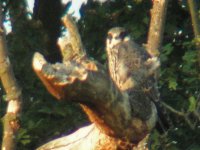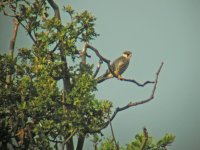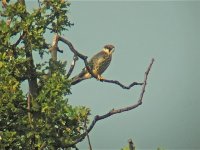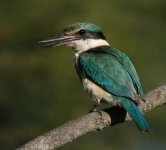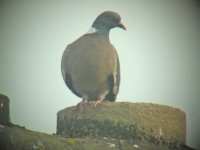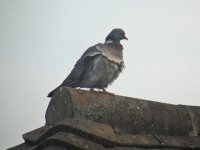I have recently bought a Kyocera sl400r and the Eagle eye shutter kit, but i am having problems geeting good quality sharp pictures. I use my camera with an Opticron scope and the picture i have taken of a young hobby was late in the evening with my scope set to 20 times , then i zoomed in on the camera . All the settings of the camera are on auto at the moment as i am still getting the hang of it . so any suggestions about the camera settings , should I set the camera to standard , landscape or macro , autoexposure etc.
-
Welcome to BirdForum, the internet's largest birding community with thousands of members from all over the world. The forums are dedicated to wild birds, birding, binoculars and equipment and all that goes with it.
Please register for an account to take part in the discussions in the forum, post your pictures in the gallery and more.
You are using an out of date browser. It may not display this or other websites correctly.
You should upgrade or use an alternative browser.
You should upgrade or use an alternative browser.
kyocera sl400r settings and sharpness (1 Viewer)
- Thread starter markho
- Start date
More options
Who Replied?marek_walford
Well-known member
Hi there,
There's not a lot of settings but try the following:
1. Set the aperture to 2.8 to give the highest shutter speed.
2. Set spot metering.
3. Set spot area focusing.
4. Shoot in standard mode.
5. Adjust the exposure depending on conditions.
6. Always shoot at ISO100.
7. Don't use digital zoom.
Cheers,
Marek
There's not a lot of settings but try the following:
1. Set the aperture to 2.8 to give the highest shutter speed.
2. Set spot metering.
3. Set spot area focusing.
4. Shoot in standard mode.
5. Adjust the exposure depending on conditions.
6. Always shoot at ISO100.
7. Don't use digital zoom.
Cheers,
Marek
marek_walford said:Hi there,
There's not a lot of settings but try the following:
1. Set the aperture to 2.8 to give the highest shutter speed.
2. Set spot metering.
3. Set spot area focusing.
4. Shoot in standard mode.
5. Adjust the exposure depending on conditions.
6. Always shoot at ISO100.
7. Don't use digital zoom.
Cheers,
Marek
Thanks as the weather is good i shall try that this evening
markho said:Thanks as the weather is good i shall try that this evening
This is the result, its a little improvement but I am still not 100% convinced about this camera . Even with the shutter kit & lens shade from eagle optics, and the settings you mentioned its still almost impossible to limit camera shake. Yesterday was an extremely hot still evening with hardly a breeze. When I look through the scope everything is nice and sharp then when i get home , its a different story.
Attachments
IanF
Moderator
I have the 3 mp Contax version which I find is a decent little camera and there are quite a few very good photos taken with the SL400 in the Gallery.
My only issues with this camera design is the poor battery life and 3 mp sensor - a 4 mp sensor would have bene so much better. The battery issue is addressed using a battery pack. Even as it is though, it can still out perform the Nikon CP4500 in some circumstances.
Using the shutter release bracket/cable and digiscoping adapter you should be able to remove camera shake entirely - provided the tripod is rock steady. I regularly go down to 1/8 or 1/15 sec shutter speeds if the subject is static.
Marek's settings advice looks pretty good - the only point I'd take issue with is the aperture. The standard advice for digiscoping was always to use maximum aperture as depth of field counts for nothing. This isn't actually true and as in most photography around f5,6 or higher usually gets better results out of the lens. Using a smaller aperture also gives noticably more depth of field. Nowadays I go for the highest aperture setting I can so as to maintain at least 1/60 - on a sunny day I can sometimes get 1/500 at f11 or higher. Sometimes though if it's dull then I'll still drop to the widest aperture and even down to 1/8 second exposure if the bird is static.
The other point to make is that although it's a scope and photos can be taken from a long way off, if you can get a bit closer then do so and the results will be markedly better. Not that this advice would help as far as the Hobby is concerned. Congratulations on getting a decent shot of such a wary bird :t:
This last shot is nicely exposed but still just a little bit soft. The limiting factor could very well be the scope optics however first I'd try using a little less camera zoom. Even with the Contax using it a 3x zoom can lead to soft photos - anywhere between 2x-3x is better and the scope eyepeice set as you have been at 20x. It's better to have less zoom and a smaller image than a full frame image that is soft. Most instances you have to crop and resize anyway - a smaller more detailed capture may just need cropping - which I always find more preferable.
It's most likely in these circumstances though that the softness is down to atmospheric pollution - in this case heat haze and really there isn't a thing you can do about that. You can't always see the heat haze clearly in the scope but all cameras seem prone to picking it up.
To test the scope combination simply take a few photos of a static subject from the scopes minimum focus distance and then maybe around 30 yards - a fence post or panel is quite useful to use as there's plenty of detail. I don't think there'll be any problems with the scope as the Opticrons are pretty good actually.
Another useful tip is that if you do have a slightly soft image then resizing it downwards to 640x480 allows for a little more sharpening and on viewing a slightly more apparently sharp image.
Also running it through a fitler program such as the freebie www.neatimage.com as I did here most often can improve results.
My only issues with this camera design is the poor battery life and 3 mp sensor - a 4 mp sensor would have bene so much better. The battery issue is addressed using a battery pack. Even as it is though, it can still out perform the Nikon CP4500 in some circumstances.
Using the shutter release bracket/cable and digiscoping adapter you should be able to remove camera shake entirely - provided the tripod is rock steady. I regularly go down to 1/8 or 1/15 sec shutter speeds if the subject is static.
Marek's settings advice looks pretty good - the only point I'd take issue with is the aperture. The standard advice for digiscoping was always to use maximum aperture as depth of field counts for nothing. This isn't actually true and as in most photography around f5,6 or higher usually gets better results out of the lens. Using a smaller aperture also gives noticably more depth of field. Nowadays I go for the highest aperture setting I can so as to maintain at least 1/60 - on a sunny day I can sometimes get 1/500 at f11 or higher. Sometimes though if it's dull then I'll still drop to the widest aperture and even down to 1/8 second exposure if the bird is static.
The other point to make is that although it's a scope and photos can be taken from a long way off, if you can get a bit closer then do so and the results will be markedly better. Not that this advice would help as far as the Hobby is concerned. Congratulations on getting a decent shot of such a wary bird :t:
This last shot is nicely exposed but still just a little bit soft. The limiting factor could very well be the scope optics however first I'd try using a little less camera zoom. Even with the Contax using it a 3x zoom can lead to soft photos - anywhere between 2x-3x is better and the scope eyepeice set as you have been at 20x. It's better to have less zoom and a smaller image than a full frame image that is soft. Most instances you have to crop and resize anyway - a smaller more detailed capture may just need cropping - which I always find more preferable.
It's most likely in these circumstances though that the softness is down to atmospheric pollution - in this case heat haze and really there isn't a thing you can do about that. You can't always see the heat haze clearly in the scope but all cameras seem prone to picking it up.
To test the scope combination simply take a few photos of a static subject from the scopes minimum focus distance and then maybe around 30 yards - a fence post or panel is quite useful to use as there's plenty of detail. I don't think there'll be any problems with the scope as the Opticrons are pretty good actually.
Another useful tip is that if you do have a slightly soft image then resizing it downwards to 640x480 allows for a little more sharpening and on viewing a slightly more apparently sharp image.
Also running it through a fitler program such as the freebie www.neatimage.com as I did here most often can improve results.
Attachments
Pie Face
Well-known member
IanF said:My only issues with this camera design is the poor battery life and 3 mp sensor - a 4 mp sensor would have bene so much better. The battery issue is addressed using a battery pack
I still have a stock of these at just £6 each inc' postage. The next batch will be a little dearer.
Mark
IanF said:I certainly recommend them Mark - it gives the camera a new lease of life and is even an impromptu charger for the camera battery :t:
Thanks alot for your advice guys i will give it a go... but good grief I thought this was going to be nice and simple for a non techie like me . Might just simply go back to watching the birds instead.
hornet
Well-known member
Hmmm. Digiscoping is many things, but simple it ain't! In fact, I'd use words like challenging, frustrating, demanding - as well as absorbing, addictive and rewarding.
I'm also using the Contax 3mp version of your camera, and have taken some pretty good shots over the last year (as well as many turkeys), but only with a lot of practice.
For me, the key learning points have been:
1) Getting used to the equipment through practice;
2) Understanding that distance matters - you can get OK shots over longish distances, but I get my best shots at perhaps 20 to 30m.
3) Getting to grips with Photoshop or Paintshop.
It might not be for a 'non-techie' like you, but don't give up too quickly - there's really nothing wrong with that Hobby shot and you could find it a useful addition to your birding. Last weekend things were so quiet at my local reserve I passed 40 minutes taking some good Wood Pigeon photographs. I've never looked at Wood Pigeons so closely in my life!
I'm also using the Contax 3mp version of your camera, and have taken some pretty good shots over the last year (as well as many turkeys), but only with a lot of practice.
For me, the key learning points have been:
1) Getting used to the equipment through practice;
2) Understanding that distance matters - you can get OK shots over longish distances, but I get my best shots at perhaps 20 to 30m.
3) Getting to grips with Photoshop or Paintshop.
It might not be for a 'non-techie' like you, but don't give up too quickly - there's really nothing wrong with that Hobby shot and you could find it a useful addition to your birding. Last weekend things were so quiet at my local reserve I passed 40 minutes taking some good Wood Pigeon photographs. I've never looked at Wood Pigeons so closely in my life!
marek_walford
Well-known member
It's possible to get decent pics with this camera. IanF's advice on getting as close as possible and keeping camera and scope zoom low is very good. Everybody has different techniques but I still prefer to keep the aperture on 2.8 to get the fastest shutter speed. I do think this is worth doing, especially if you are having bluring problems (possibly due to camera shake). However, as Ian says this is very likely due to atmospheric conditions.
Also, make sure the camera locks focus - half press the shutter and you should get a green light (it flashes when it can't lock focus). If it doesn't lock try again and it often will, or try another focus option.
Hobbies are not an easy bird to photograph (your 2nd pic is pretty good!). Practice on something really easy like a very close sleeping duck.
See http://www.berksbirds.co.uk/birdphotography/index.asp for some of my pics. You can search by camera to just see the Kyocera pics. The Bee-eater pics were distant (not great quality), the G C Grebe was much close (better quality). Keep trying and you'll get there!
Also, make sure the camera locks focus - half press the shutter and you should get a green light (it flashes when it can't lock focus). If it doesn't lock try again and it often will, or try another focus option.
Hobbies are not an easy bird to photograph (your 2nd pic is pretty good!). Practice on something really easy like a very close sleeping duck.
See http://www.berksbirds.co.uk/birdphotography/index.asp for some of my pics. You can search by camera to just see the Kyocera pics. The Bee-eater pics were distant (not great quality), the G C Grebe was much close (better quality). Keep trying and you'll get there!
Pie Face
Well-known member
Totally agree with Ian and Merek. I think that most (including myself) new to digiscoping birders get the impression that they can get great results on birds that are half-a mile away the same rules apply to digiscoping as any form of photography forget about the distant stuff get to grips with the close birds. Have a look at www.rothervalley.f9.co.uk (click on the bird news) all my photos that appear there in the last year have been taken with my Kyocera I much prefer it to my coolpix 995 because it's faster, lets in more light and also because of the large F stop is not as critical to focus. Stick with it but do get a battery pack and a couple of sets of 2000+milliamp Nickel Metal Hydride batteries, whether from me or Pennine because just as you've got that killer shot the camera will go dead. Last November at the Masked Shrike my dedicated batteries lasted 10 minutes - that was all my batteries, all 3 of them!!
Mark
Mark
The problems I see in your photos are not the camera. Most likely the scope eyepiece and/or the heat haze as Ian mentioned. The attached photo was taken with the Kyocera SL400R with the Swarovski scope and 20-60 eyepiece in good light (the light in Sydney is usually very good ). Neil.
Attachments
IanF
Moderator
Neil's photo says it all really. Digiscope shots don't come much better than this whichever camera is used.
One thing on the focus lock. Every time I take a shot I use the cable release to lock the focus and then check focus on the LCD. What looks sharp on the camera LCD isn't always the same as what looks sharp once the focus is locked. The CP4500 seems more prone to this than the Contax, but I often refocus the scope slightly whilst the shutter is half depressed, mainly concentrating on getting the eye the sharpest.
One thing on the focus lock. Every time I take a shot I use the cable release to lock the focus and then check focus on the LCD. What looks sharp on the camera LCD isn't always the same as what looks sharp once the focus is locked. The CP4500 seems more prone to this than the Contax, but I often refocus the scope slightly whilst the shutter is half depressed, mainly concentrating on getting the eye the sharpest.
Pie Face
Well-known member
IanF said:Neil's photo says it all really. Digiscope shots don't come much better than this whichever camera is used.
One thing on the focus lock. Every time I take a shot I use the cable release to lock the focus and then check focus on the LCD. What looks sharp on the camera LCD isn't always the same as what looks sharp once the focus is locked. The CP4500 seems more prone to this than the Contax, but I often refocus the scope slightly whilst the shutter is half depressed, mainly concentrating on getting the eye the sharpest.
Agreed.
Deja-vu said:Agreed.
Thanks again for the advice , Niel's photo is definitely what I thought I would be achieving straight away. Just have to work at it I guess.
Digital Dingbat
Well-known member
I was very interested in your comments about focussing - I was using the infinity setting on the camera and then using the scope to focus. Are there some pitfalls with this approach?
IanF
Moderator
It's swings and roundabouts.Digital Dingbat said:I was very interested in your comments about focussing - I was using the infinity setting on the camera and then using the scope to focus. Are there some pitfalls with this approach?
In the main I use the close up setting as it seems to work better for me using the brackets to pick out the head area for the camera to focus on. I'm not averse to using the infinity setting as well especially when there's poor contrast causing the camera to hunt for focus and the subject is fairly static.
Either way works just as well, the important thing I find is not to just rely on the camera autofocus - it ensures some bits are sharp but not neccessarily the bit you want, which is why I lock the focus and refocus using the scope control.
Digital Dingbat said:I was very interested in your comments about focussing - I was using the infinity setting on the camera and then using the scope to focus. Are there some pitfalls with this approach?
I always use the Macro setting as well on all my cameras for digiscoping and let the camera Auto-focus.Neil.
Neil said:I always use the Macro setting as well on all my cameras for digiscoping and let the camera Auto-focus.Neil.
I have taken a few practise shots this afternoon of birds in the garden. The light wasn't to good a little cloudy and overcast, and I also shot through the patio windows. However I could see an improvement in the camera's performance after taking the advice, most shots came out reasonably sharp without any editing .
I also took all my shots on macro which does seem to make focusing easier. Off to the WWT tomorrow for more practise on easy birds.
Attachments
markho said:I have taken a few practise shots this afternoon of birds in the garden. The light wasn't to good a little cloudy and overcast, and I also shot through the patio windows. However I could see an improvement in the camera's performance after taking the advice, most shots came out reasonably sharp without any editing .
I also took all my shots on macro which does seem to make focusing easier. Off to the WWT tomorrow for more practise on easy birds.
This picture is the one I should of uploaded , you can tell a difference in sharpness.
Attachments
Users who are viewing this thread
Total: 2 (members: 0, guests: 2)




